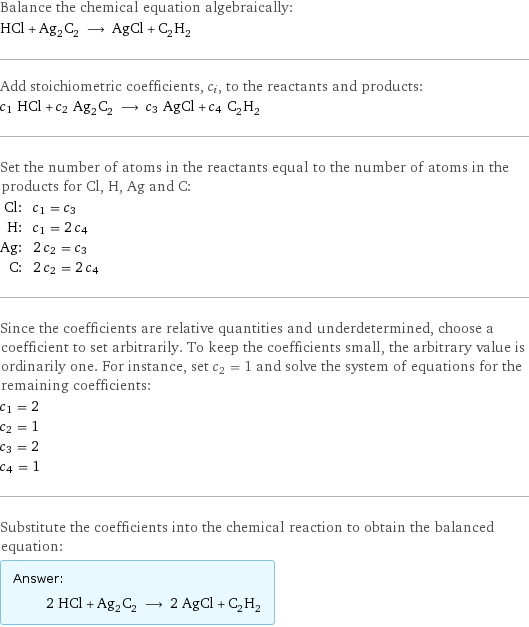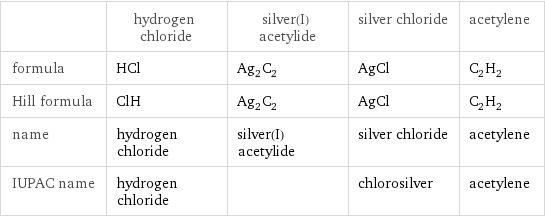Input interpretation

HCl hydrogen chloride + Ag_2C_2 silver(I) acetylide ⟶ AgCl silver chloride + C_2H_2 acetylene
Balanced equation

Balance the chemical equation algebraically: HCl + Ag_2C_2 ⟶ AgCl + C_2H_2 Add stoichiometric coefficients, c_i, to the reactants and products: c_1 HCl + c_2 Ag_2C_2 ⟶ c_3 AgCl + c_4 C_2H_2 Set the number of atoms in the reactants equal to the number of atoms in the products for Cl, H, Ag and C: Cl: | c_1 = c_3 H: | c_1 = 2 c_4 Ag: | 2 c_2 = c_3 C: | 2 c_2 = 2 c_4 Since the coefficients are relative quantities and underdetermined, choose a coefficient to set arbitrarily. To keep the coefficients small, the arbitrary value is ordinarily one. For instance, set c_2 = 1 and solve the system of equations for the remaining coefficients: c_1 = 2 c_2 = 1 c_3 = 2 c_4 = 1 Substitute the coefficients into the chemical reaction to obtain the balanced equation: Answer: | | 2 HCl + Ag_2C_2 ⟶ 2 AgCl + C_2H_2
Structures

+ ⟶ +
Names

hydrogen chloride + silver(I) acetylide ⟶ silver chloride + acetylene
Equilibrium constant
![Construct the equilibrium constant, K, expression for: HCl + Ag_2C_2 ⟶ AgCl + C_2H_2 Plan: • Balance the chemical equation. • Determine the stoichiometric numbers. • Assemble the activity expression for each chemical species. • Use the activity expressions to build the equilibrium constant expression. Write the balanced chemical equation: 2 HCl + Ag_2C_2 ⟶ 2 AgCl + C_2H_2 Assign stoichiometric numbers, ν_i, using the stoichiometric coefficients, c_i, from the balanced chemical equation in the following manner: ν_i = -c_i for reactants and ν_i = c_i for products: chemical species | c_i | ν_i HCl | 2 | -2 Ag_2C_2 | 1 | -1 AgCl | 2 | 2 C_2H_2 | 1 | 1 Assemble the activity expressions accounting for the state of matter and ν_i: chemical species | c_i | ν_i | activity expression HCl | 2 | -2 | ([HCl])^(-2) Ag_2C_2 | 1 | -1 | ([Ag2C2])^(-1) AgCl | 2 | 2 | ([AgCl])^2 C_2H_2 | 1 | 1 | [C2H2] The equilibrium constant symbol in the concentration basis is: K_c Mulitply the activity expressions to arrive at the K_c expression: Answer: | | K_c = ([HCl])^(-2) ([Ag2C2])^(-1) ([AgCl])^2 [C2H2] = (([AgCl])^2 [C2H2])/(([HCl])^2 [Ag2C2])](../image_source/9e99326dffe3e3c7a470af978f79e003.png)
Construct the equilibrium constant, K, expression for: HCl + Ag_2C_2 ⟶ AgCl + C_2H_2 Plan: • Balance the chemical equation. • Determine the stoichiometric numbers. • Assemble the activity expression for each chemical species. • Use the activity expressions to build the equilibrium constant expression. Write the balanced chemical equation: 2 HCl + Ag_2C_2 ⟶ 2 AgCl + C_2H_2 Assign stoichiometric numbers, ν_i, using the stoichiometric coefficients, c_i, from the balanced chemical equation in the following manner: ν_i = -c_i for reactants and ν_i = c_i for products: chemical species | c_i | ν_i HCl | 2 | -2 Ag_2C_2 | 1 | -1 AgCl | 2 | 2 C_2H_2 | 1 | 1 Assemble the activity expressions accounting for the state of matter and ν_i: chemical species | c_i | ν_i | activity expression HCl | 2 | -2 | ([HCl])^(-2) Ag_2C_2 | 1 | -1 | ([Ag2C2])^(-1) AgCl | 2 | 2 | ([AgCl])^2 C_2H_2 | 1 | 1 | [C2H2] The equilibrium constant symbol in the concentration basis is: K_c Mulitply the activity expressions to arrive at the K_c expression: Answer: | | K_c = ([HCl])^(-2) ([Ag2C2])^(-1) ([AgCl])^2 [C2H2] = (([AgCl])^2 [C2H2])/(([HCl])^2 [Ag2C2])
Rate of reaction
![Construct the rate of reaction expression for: HCl + Ag_2C_2 ⟶ AgCl + C_2H_2 Plan: • Balance the chemical equation. • Determine the stoichiometric numbers. • Assemble the rate term for each chemical species. • Write the rate of reaction expression. Write the balanced chemical equation: 2 HCl + Ag_2C_2 ⟶ 2 AgCl + C_2H_2 Assign stoichiometric numbers, ν_i, using the stoichiometric coefficients, c_i, from the balanced chemical equation in the following manner: ν_i = -c_i for reactants and ν_i = c_i for products: chemical species | c_i | ν_i HCl | 2 | -2 Ag_2C_2 | 1 | -1 AgCl | 2 | 2 C_2H_2 | 1 | 1 The rate term for each chemical species, B_i, is 1/ν_i(Δ[B_i])/(Δt) where [B_i] is the amount concentration and t is time: chemical species | c_i | ν_i | rate term HCl | 2 | -2 | -1/2 (Δ[HCl])/(Δt) Ag_2C_2 | 1 | -1 | -(Δ[Ag2C2])/(Δt) AgCl | 2 | 2 | 1/2 (Δ[AgCl])/(Δt) C_2H_2 | 1 | 1 | (Δ[C2H2])/(Δt) (for infinitesimal rate of change, replace Δ with d) Set the rate terms equal to each other to arrive at the rate expression: Answer: | | rate = -1/2 (Δ[HCl])/(Δt) = -(Δ[Ag2C2])/(Δt) = 1/2 (Δ[AgCl])/(Δt) = (Δ[C2H2])/(Δt) (assuming constant volume and no accumulation of intermediates or side products)](../image_source/ca76f80d908f74baa1c05b66db76c46b.png)
Construct the rate of reaction expression for: HCl + Ag_2C_2 ⟶ AgCl + C_2H_2 Plan: • Balance the chemical equation. • Determine the stoichiometric numbers. • Assemble the rate term for each chemical species. • Write the rate of reaction expression. Write the balanced chemical equation: 2 HCl + Ag_2C_2 ⟶ 2 AgCl + C_2H_2 Assign stoichiometric numbers, ν_i, using the stoichiometric coefficients, c_i, from the balanced chemical equation in the following manner: ν_i = -c_i for reactants and ν_i = c_i for products: chemical species | c_i | ν_i HCl | 2 | -2 Ag_2C_2 | 1 | -1 AgCl | 2 | 2 C_2H_2 | 1 | 1 The rate term for each chemical species, B_i, is 1/ν_i(Δ[B_i])/(Δt) where [B_i] is the amount concentration and t is time: chemical species | c_i | ν_i | rate term HCl | 2 | -2 | -1/2 (Δ[HCl])/(Δt) Ag_2C_2 | 1 | -1 | -(Δ[Ag2C2])/(Δt) AgCl | 2 | 2 | 1/2 (Δ[AgCl])/(Δt) C_2H_2 | 1 | 1 | (Δ[C2H2])/(Δt) (for infinitesimal rate of change, replace Δ with d) Set the rate terms equal to each other to arrive at the rate expression: Answer: | | rate = -1/2 (Δ[HCl])/(Δt) = -(Δ[Ag2C2])/(Δt) = 1/2 (Δ[AgCl])/(Δt) = (Δ[C2H2])/(Δt) (assuming constant volume and no accumulation of intermediates or side products)
Chemical names and formulas

| hydrogen chloride | silver(I) acetylide | silver chloride | acetylene formula | HCl | Ag_2C_2 | AgCl | C_2H_2 Hill formula | ClH | Ag_2C_2 | AgCl | C_2H_2 name | hydrogen chloride | silver(I) acetylide | silver chloride | acetylene IUPAC name | hydrogen chloride | | chlorosilver | acetylene
Substance properties

| hydrogen chloride | silver(I) acetylide | silver chloride | acetylene molar mass | 36.46 g/mol | 239.758 g/mol | 143.32 g/mol | 26.038 g/mol phase | gas (at STP) | | solid (at STP) | gas (at STP) melting point | -114.17 °C | | 455 °C | -81 °C boiling point | -85 °C | | 1554 °C | -75 °C density | 0.00149 g/cm^3 (at 25 °C) | | 5.56 g/cm^3 | 0.618 g/cm^3 (at -55 °C) solubility in water | miscible | | | surface tension | | | | 0.01431 N/m
Units
